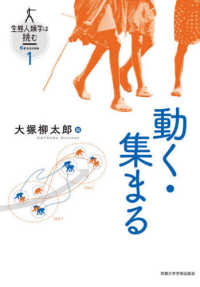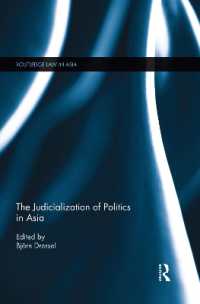Full Description
Individually and collectively, resident microbes play important roles in host health and survival. Shaping and shaped by their host environments, these microorganisms form intricate communities that are in a state of dynamic equilibrium. This ecologic and dynamic view of host-microbe interactions is rapidly redefining our view of health and disease. It is now accepted that the vast majority of microbes are, for the most part, not intrinsically harmful, but rather become established as persistent, co-adapted colonists in equilibrium with their environment, providing useful goods and services to their hosts while deriving benefits from these host associations. Disruption of such alliances may have consequences for host health, and investigations in a wide variety of organisms have begun to illuminate the complex and dynamic network of interaction - across the spectrum of hosts, microbes, and environmental niches - that influence the formation, function, and stability of host-associated microbial communities.
Microbial Ecology in States of Health and Disease is the summary of a workshop convened by the Institute of Medicine's Forum on Microbial Threats in March 2013 to explore the scientific and therapeutic implications of microbial ecology in states of health and disease. Participants explored host-microbe interactions in humans, animals, and plants; emerging insights into how microbes may influence the development and maintenance of states of health and disease; the effects of environmental change(s) on the formation, function, and stability of microbial communities; and research challenges and opportunities for this emerging field of inquiry.
Table of Contents
Front Matter
Workshop Overview
A1 Effector and memory T cell responses to commensal bacteria--Yasmine Belkaid, Nicolas Bouladoux, and Timothy W. Hand
A2 What are the consequences of the disappearing human microbiota?--Martin J. Blaser and Stanley Falkow
A3 Pathways in microbe-induced obesity--Laura M. Cox and Martin J. Blaser
A4 Microbial exposure during early life has persistent effects on natural killer T Cell function--Torsten Olszak, Dingding An, Sebastian Zeissig, Miguel Penilla Vera, Julia Richter, Andre Franke, Jonathan N. Glickman, Reiner Siebert, Rebecca M. Barron, Dennis L. Kasper, and Richard S. Blumberg
A5 The application of ecological theory toward an understanding of the human microbiome--Elizabeth K. Costello, Keaton Stagaman, Les Dethlefsen, Brendan J. M. Bohannan, and David A. Relman
A6 Seasonal restructuring of the ground squirrel gutmicrobiota over the annual hibernation cycle--Hannah V. Carey, William A. Walters, and Rob Knight
A7 Lessons from studying insect symbioses--Angela E. Douglas
A8 A new vision of immunity: homeostasis of the superorganism--Grard Eberl
A9 Host defense and immunomodulation of mucosal candidiasis--Paul L. Fidel, Jr., and Mairi C. Noverr
A10 Microbiota-targeted therapies: An ecological perspective--Katherine P. Lemon, Gary C. Armitage, David A. Relman, and Michael Fischbach
A11 Community ecology and the vaginal microbiome--Larry J. Forney and Jacques Ravel
A12 Investigating bacterial-animal symbioses with light sheet microscopy--Michael J. Taormina, Matthew Jemielita, W. Zac Stephens, Adam R. Burns, Joshua V. Troll, Raghuveer Parthasarathy, and Karen Guillemin
A13 Clinical application of fecal microbiota transplantation in Clostridium difficile infection and beyond--Josbert J. Keller and Els van Nood
A14 Consumption of human milk glycoconjugates by infant-associated bifidobacteria: Mechanisms and implications--Daniel Garrido, David C. Dallas, and David A. Mills
A15 Bacteriophage adhering to mucus providea nonhost-derived immunity--Jeremy J. Barr, Rita Auro, Mike Furlan, Katrine L. Whiteson, Marcella L. Erb, Joe Pogliano, Aleksandr Stotland, Roland Wolkowicz, Andrew S. Cutting, Kelly S. Doran, Peter Salamon, Merry Youle, and Forest Rohwer
A16 Topographic diversity of fungal and bacterial communities in human skin--Keisha Findley, Julia Oh, Joy Yang, Sean Conlan, Clayton Deming, Jennifer A. Meyer, Deborah Schoenfeld, Effie Nomicos, Morgan Park, NIH Intramural Sequencing Center Comparative Sequencing Program, Heidi H. Kong, and Julia A. Segre
A17 Distinct microbial communities within the endosphere and rhizosphere of Populus deltoides roots across contrasting soil types--Neil R. Gottel, Hector F. Castro, Marilyn Kerley, Zamin Yang, Dale A. Pelletier, Mircea Podar, Tatiana Karpinets, Ed Uberbacher, Gerald A. Tuskan, Rytas Vilgalys, Mitchel J. Doktycz, and Christopher W. Schadt
A18 Interactions between commensal fungi and the C-type lectin receptor Dectin-1 influence colitis--Iliyan D. Iliev, Vincent A. Funari, Kent D. Taylor, Quoclinh Nguyen, Christopher N. Reyes, Samuel P. Strom, Jordan Brown, Courtney A. Becker, Phillip R. Fleshner, Marla Dubinsky, Jerome I. Rotter, Hanlin L. Wang, Dermot P. B. McGovern, Gordon D. Brown, and David M. Underhill
A19 Metagenomics and personalized medicine--Herbert W. Virgin and John A. Todd
A20 From genetics of inflammatory bowel disease towards mechanistic insights--Daniel B. Graham and Ramnik J. Xavier
A21 Antimicrobial peptides and the microbiome--Michael Zasloff
Appendix B: Agenda
Appendix C: Acronyms
Appendix D: Glossary
Appendix E: Speaker Biographies
Contents
1 Front Matter; 2 Workshop Overview; 3 A1 Effector and memory T cell responses to commensal bacteria--Yasmine Belkaid, Nicolas Bouladoux, and Timothy W. Hand; 4 A2 What are the consequences of the disappearing human microbiota?--Martin J. Blaser and Stanley Falkow; 5 A3 Pathways in microbe-induced obesity--Laura M. Cox and Martin J. Blaser; 6 A4 Microbial exposure during early life has persistent effects on natural killer T Cell function--Torsten Olszak, Dingding An, Sebastian Zeissig, Miguel Penilla Vera, Julia Richter, Andre Franke, Jonathan N. Glickman, Reiner Siebert, Rebecca M. Barron, Dennis L. Kasper, and Richard S. Blumberg; 7 A5 The application of ecological theory toward an understanding of the human microbiome--Elizabeth K. Costello, Keaton Stagaman, Les Dethlefsen, Brendan J. M. Bohannan, and David A. Relman; 8 A6 Seasonal restructuring of the ground squirrel gutmicrobiota over the annual hibernation cycle--Hannah V. Carey, William A. Walters, and Rob Knight; 9 A7 Lessons from studying insect symbioses--Angela E. Douglas; 10 A8 A new vision of immunity: homeostasis of the superorganism--Grard Eberl; 11 A9 Host defense and immunomodulation of mucosal candidiasis--Paul L. Fidel, Jr., and Mairi C. Noverr; 12 A10 Microbiota-targeted therapies: An ecological perspective--Katherine P. Lemon, Gary C. Armitage, David A. Relman, and Michael Fischbach; 13 A11 Community ecology and the vaginal microbiome--Larry J. Forney and Jacques Ravel; 14 A12 Investigating bacterial-animal symbioses with light sheet microscopy--Michael J. Taormina, Matthew Jemielita, W. Zac Stephens, Adam R. Burns, Joshua V. Troll, Raghuveer Parthasarathy, and Karen Guillemin; 15 A13 Clinical application of fecal microbiota transplantation in Clostridium difficile infection and beyond--Josbert J. Keller and Els van Nood; 16 A14 Consumption of human milk glycoconjugates by infant-associated bifidobacteria: Mechanisms and implications--Daniel Garrido, David C. Dallas, and David A. Mills; 17 A15 Bacteriophage adhering to mucus providea nonhost-derived immunity--Jeremy J. Barr, Rita Auro, Mike Furlan, Katrine L. Whiteson, Marcella L. Erb, Joe Pogliano, Aleksandr Stotland, Roland Wolkowicz, Andrew S. Cutting, Kelly S. Doran, Peter Salamon, Merry Youle, and Forest Rohwer; 18 A16 Topographic diversity of fungal and bacterial communities in human skin--Keisha Findley, Julia Oh, Joy Yang, Sean Conlan, Clayton Deming, Jennifer A. Meyer, Deborah Schoenfeld, Effie Nomicos, Morgan Park, NIH Intramural Sequencing Center Comparative Sequencing Program, Heidi H. Kong, and Julia A. Segre; 19 A17 Distinct microbial communities within the endosphere and rhizosphere of Populus deltoides roots across contrasting soil types--Neil R. Gottel, Hector F. Castro, Marilyn Kerley, Zamin Yang, Dale A. Pelletier, Mircea Podar, Tatiana Karpinets, Ed Uberbacher, Gerald A. Tuskan, Rytas Vilgalys, Mitchel J. Doktycz, and Christopher W. Schadt; 20 A18 Interactions between commensal fungi and the C-type lectin receptor Dectin-1 influence colitis--Iliyan D. Iliev, Vincent A. Funari, Kent D. Taylor, Quoclinh Nguyen, Christopher N. Reyes, Samuel P. Strom, Jordan Brown, Courtney A. Becker, Phillip R. Fleshner, Marla Dubinsky, Jerome I. Rotter, Hanlin L. Wang, Dermot P. B. McGovern, Gordon D. Brown, and David M. Underhill; 21 A19 Metagenomics and personalized medicine--Herbert W. Virgin and John A. Todd; 22 A20 From genetics of inflammatory bowel disease towards mechanistic insights--Daniel B. Graham and Ramnik J. Xavier; 23 A21 Antimicrobial peptides and the microbiome--Michael Zasloff; 24 Appendix B: Agenda; 25 Appendix C: Acronyms; 26 Appendix D: Glossary; 27 Appendix E: Speaker Biographies







